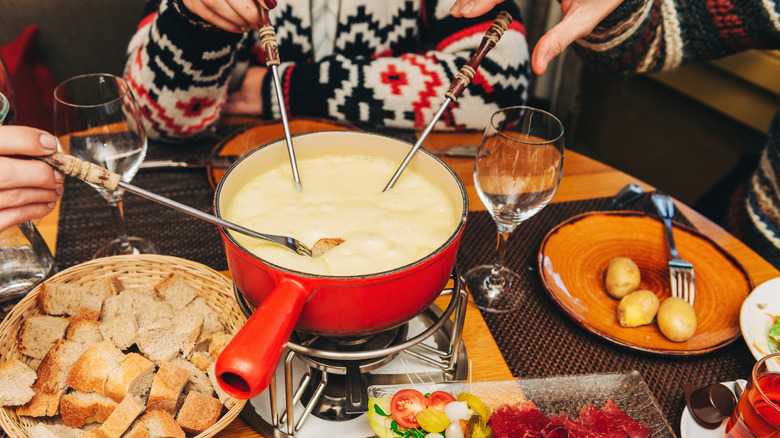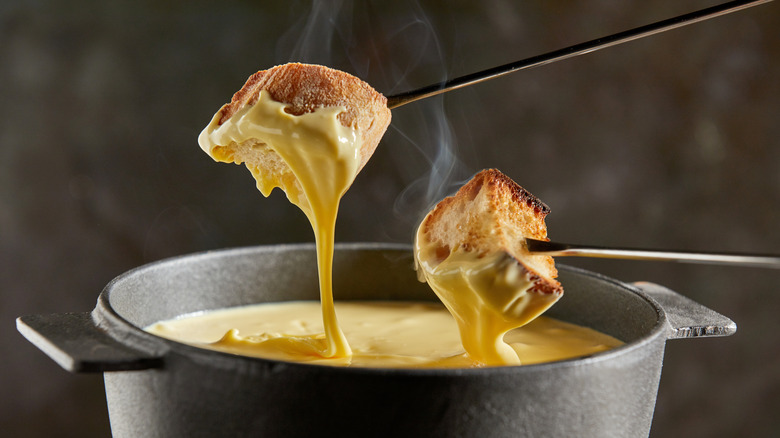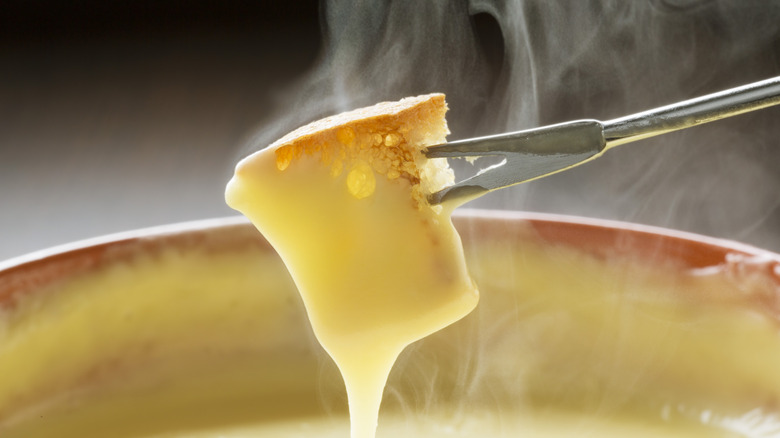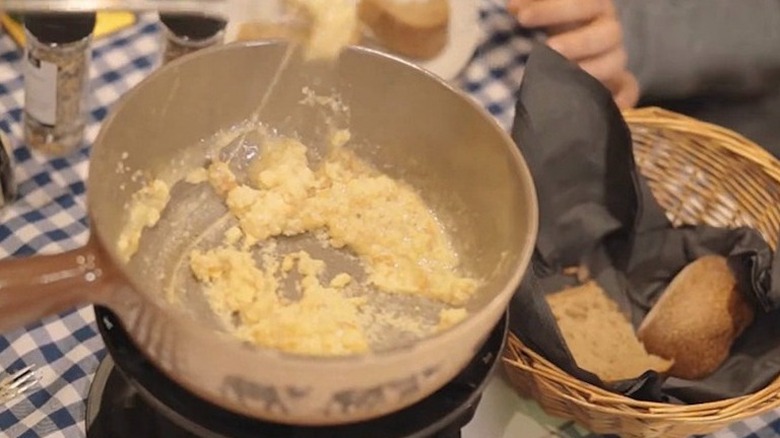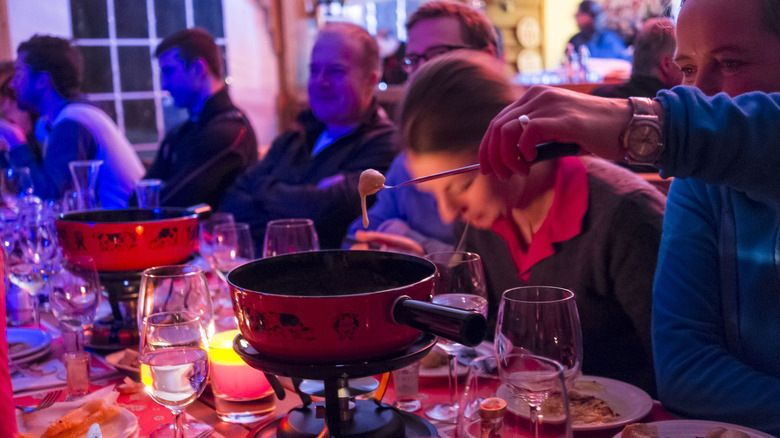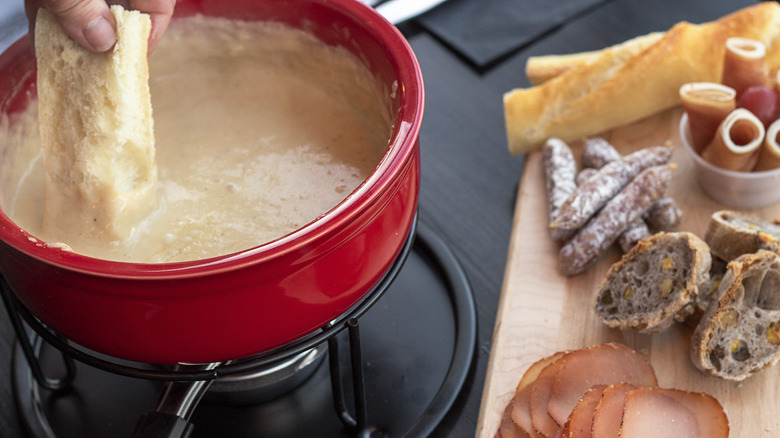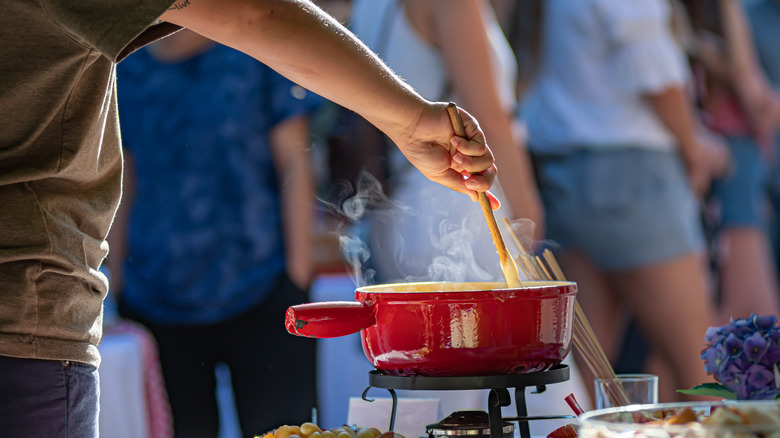Here's What You Need To Know About Fondue Etiquette
Dipping bread and other assorted ingredients into a bubbling pot of melted cheese is often considered a distinctly 1970s food trend. But in recent years, fondue has undergone a kind of renaissance. The Swiss dish has started to reappear in restaurants and home kitchens alike.
Cheese fondue has a long and serious history as a food tradition — it is not just a dinner party cliché. One of the first written records of the dish is thousands of years old, appearing in Homer's "The Iliad," one of the most significant literary works in history. Hundreds of years ago, fondue was even a staple of peasants living in Switzerland. In addition to being historic, fondue has a long list of attributes. It is simple, communal, and indulgent. However, there is one distinct issue with the dish: etiquette.
Enjoying fondue requires a heightened adherence to manners and table-side behavior. This is because of the dish's communal nature. When sharing food, it's important to stick to rules like these, as to prevent cross-contamination. These rules also help to make sure that each diner gets a substantial serving of food. Here is everything you need to know about fondue etiquette.
Don't double dip
Double dipping is the act of inserting your food into a shared dish, taking a bite, and then going back for seconds. This practice can occur when eating things other than fondue, such as chips and salsa. However, double-dipping is something that must be avoided by all who enjoy fondue. This is not just a matter of squeamishness, but hygiene. A study published in The British Medical Journal found that double-dipped foods transfer between 50 and 100 bacteria with every contaminated bite.
While we don't recommend double-dipping while sharing fondue, there is one positive we can take away from The British Medical Journal's study. This research shows that, compared to other foods, cheese dips such as fondue are not great at harboring bacteria. This means the number of germs transmitted while sharing fondue will be at the lower end of the spectrum.
Food scientist Brian Sheldon explained why this is to WBUR: "Salsa actually had more bacteria transferred than the cheese fondue or chocolate dip [in our study]. And when you think about it, it's common sense because salsa is much thinner, so more inoculated salsa, if you will, is dropping back off the cracker or chip back into that common bowl than with the other two."
Only drink certain beverages
Switzerland is often thought of as the birthplace of fondue. In this country, only two beverages are deemed acceptable to drink alongside the dish: white wine and tea. For the wine, the traditional option is Chasselas, a type of Swiss white wine.
Chasselas wines taste mostly neutral and inoffensive, being low in alcohol content and acidity. This simple beverage is a great complement to the rich dish of fondue. But complementary characteristics are only part of the reason why white wine and tea are favored. More importantly, there is a widely-held belief that these beverages aid in the digestion of melted cheese, helping to prevent diners from discomfort.
A study in The British Medical Journal revealed a crack in this theory. Research showed that having white wine with fondue may not be the best idea. This study proved that consuming various alcoholic beverages with melted cheese seemed to slow digestion, rather than improve it. However, black tea did seem to do the trick, working to alleviate common symptoms of indigestion such as bloating. This makes sense, as it's one of the best teas to settle an upset stomach. If a comfortable evening is what you're after, have tea with your fondue.
Avoid eating off your fondue fork
Traditionally, Swiss cheeses like Emmental and Gruyère are used to make fondue. Of course, the cheese must be melted before the fondue can be enjoyed. This process requires using temperatures as high as 300 degrees Fahrenheit. After preparing, the fondue must remain hot to remain properly liquified. Consequently, fondue is a dish that is kept very hot. The risk of serious burns is the primary reason why diners should never eat directly from their fondue fork. If you place your fork directly into your mouth, you could seriously hurt something in there.
Oral bacteria is another reason to avoid eating off of your fondue fork. Put simply, our mouths are home to hundreds of strains of bacteria. According to East Orlando Dental, saliva acts as a vehicle for these bacteria, transporting them from one mouth to another. If this happens, cavities can form, or illnesses like mononucleosis can spread (via Verywell Health). Avoid double-dipping, as well as eating off your fork. This will keep you and other diners safe when enjoying fondue.
Share la religieuse
If fondue is made, served, and consumed correctly, a thin crust of golden cheese will form at the bottom of the pot. Near the end of the meal, when most of the cheese has been consumed, this cheese crust is revealed. This crisp layer is called "la religieuse," a French term that means "the nun." It is considered so special that it must be shared. In this way, la religieuse is similar to socarrat, the crunchy bottom layer of paella.
To enjoy la religieuse, wait for the fondue pot to cool. At this point, the bottom layer hardens even more. It can then easily be removed from the pot with a knife, broken into pieces, and shared between guests. Alternatively, an egg can be cracked into the fondue pot and mixed with la religieuse. This egg dish is another popular way that some like to eat this hard cheese layer.
Prepare to pay a forfeit
Historic dishes tend to come with unique traditions. For example, people celebrating Christmas in the United Kingdom will place a coin in their Christmas pudding every year. With fondue, one of the most special rituals is called the forfeit.
This tradition is triggered when a guest accidentally drops a piece of their food in the fondue pot. Whoever does this is then prompted to make up for it somehow. Popular punishments include making that person buy everyone a round of drinks. However, guests can come up with their own unique forfeit rule if they wish.
To avoid having to pay a forfeit, make sure that every piece of bread still has some crust attached. This will lend it greater structural stability. People even recommend using stale loaves of bread. These dry carbohydrates work well with fondue, as the hot cheese will soften it, but doesn't cause it to disintegrate. Another tip is to not submerge your bread for too long. As with dunking a biscuit in tea, the period when you submerge the bread should be a short one. Any longer and it will begin to turn soggy and fall apart.
Twirl to avoid dripping
If not handled properly, melted cheese can quickly make a mess. This is especially true when eating fondue, as diners are constantly ferrying pieces of dripping bread to and from the communal pot. The general advice is to twirl your fork three times while holding it above the fondue pot.
This method allows excess cheese to fall off without making a mess. It also limits the amount of waste created, since less cheese will fall by the wayside. People also recommend twirling your bread before removing it from the melted cheese, to ensure that each bite is evenly coated.
The consistency of your cheese will partly determine how much dripping occurs. If the mixture is far too loose, add some cornstarch or flour. The general rule of thumb is one tablespoon per pound of cheese. Some cheeses form a better consistency when melted than others. Emmental is a type of cheese known for creating a good thickness.
Avoid using your hands
In many cultures, using cutlery is the traditional way to consume food. Americans and other Westerners will occasionally use their hands to eat some dishes, like pizza, burgers, or tacos. But forks, knives, and spoons are the norm during dining. We recommend sticking to using utensils when eating fondue, as well.
Using your hands to eat fondue is not advisable. This method poses certain risks, including the spread of germs. But this strategy also puts diners in harm's way. Fondue pots and cheese are extremely hot, making those eating with their hands susceptible to burns.
The most hygienic way of eating fondue is to use a fondue fork. This fork should be utilized for dipping different foods, like bread. Once dipped, your bread should be removed from the fondue fork using a regular utensil. Finally, the bread can be speared and eaten with a regular fork while on your plate.
Keep the fondue fresh by stirring
When initially melting the cheese, some prefer to stir with a whisk as opposed to a spoon. Some think the whisk creates more movement, thus making the stirring more effective.
Once a fondue is prepared and on the table, you should continue stirring it. This is a necessary step in preventing the cheese from burning at the bottom or developing an unpleasant crust on top. Stirring also ensures that all the fondue ingredients remain combined. Many recommend that you stir the fondue in a figure-eight pattern or a clockwise motion. This stirring can be done by the diners themselves, using their skewered fondue forks.
However, it is frowned upon to dip into the fondue pot when another fork is already submerged. If two people attempt to stir simultaneously, forks can clash, possibly dislodging whatever you have speared. This is why you should always take turns when dipping into the fondue pot.
